Impact of Breast Implants on Nursing Care for Young Women: A Report
VerifiedAdded on 2022/10/12
|5
|898
|68
Report
AI Summary
This report examines the challenges nurses face in providing care to young women undergoing breast implant surgery, focusing on the impact of their values and beliefs. It highlights the limited research in this area and the need for nurses to provide safe and responsive care, irrespective of cultural backgrounds. The report emphasizes the importance of self-assessment, the Johari window, and reflective practice for nurses to reduce conflicts, improve self-awareness, and empower patients. It also discusses the implications of this knowledge for addressing patient needs, reducing psychological distress, and promoting literacy. The report concludes by emphasizing the importance of evidence-based knowledge and nonjudgmental attitudes in improving patient outcomes.
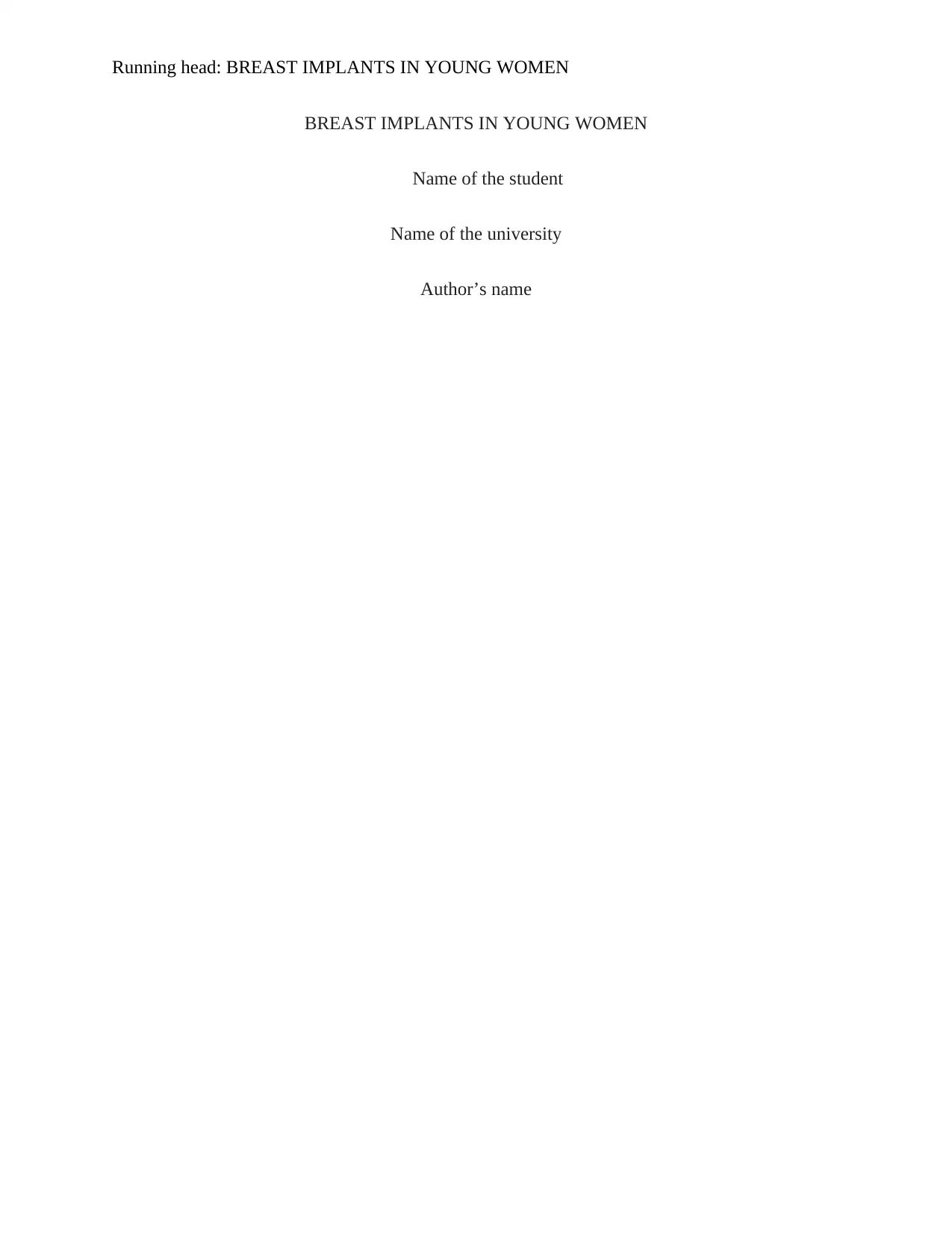
Running head: BREAST IMPLANTS IN YOUNG WOMEN
BREAST IMPLANTS IN YOUNG WOMEN
Name of the student
Name of the university
Author’s name
BREAST IMPLANTS IN YOUNG WOMEN
Name of the student
Name of the university
Author’s name
Paraphrase This Document
Need a fresh take? Get an instant paraphrase of this document with our AI Paraphraser
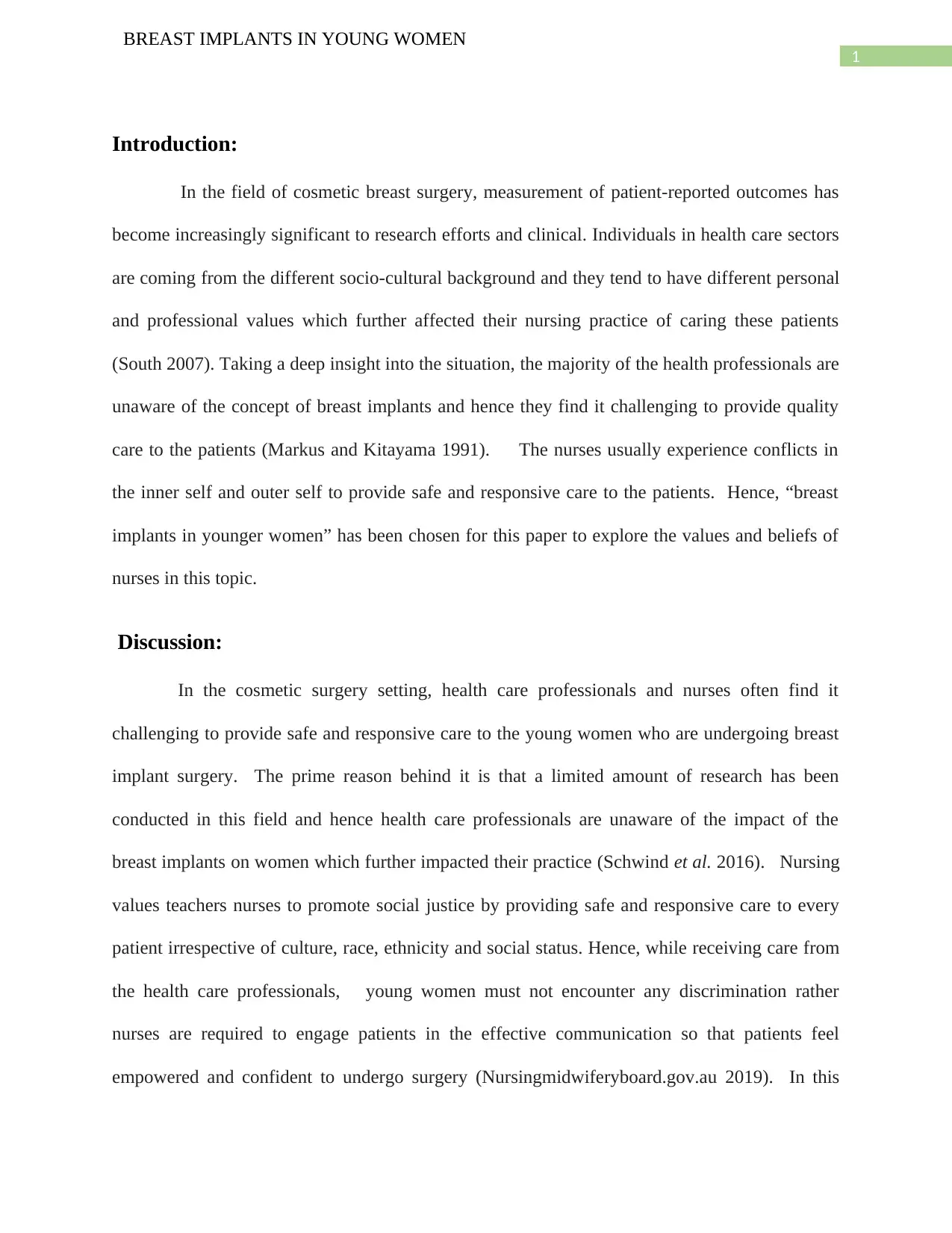
1
BREAST IMPLANTS IN YOUNG WOMEN
Introduction:
In the field of cosmetic breast surgery, measurement of patient-reported outcomes has
become increasingly significant to research efforts and clinical. Individuals in health care sectors
are coming from the different socio-cultural background and they tend to have different personal
and professional values which further affected their nursing practice of caring these patients
(South 2007). Taking a deep insight into the situation, the majority of the health professionals are
unaware of the concept of breast implants and hence they find it challenging to provide quality
care to the patients (Markus and Kitayama 1991). The nurses usually experience conflicts in
the inner self and outer self to provide safe and responsive care to the patients. Hence, “breast
implants in younger women” has been chosen for this paper to explore the values and beliefs of
nurses in this topic.
Discussion:
In the cosmetic surgery setting, health care professionals and nurses often find it
challenging to provide safe and responsive care to the young women who are undergoing breast
implant surgery. The prime reason behind it is that a limited amount of research has been
conducted in this field and hence health care professionals are unaware of the impact of the
breast implants on women which further impacted their practice (Schwind et al. 2016). Nursing
values teachers nurses to promote social justice by providing safe and responsive care to every
patient irrespective of culture, race, ethnicity and social status. Hence, while receiving care from
the health care professionals, young women must not encounter any discrimination rather
nurses are required to engage patients in the effective communication so that patients feel
empowered and confident to undergo surgery (Nursingmidwiferyboard.gov.au 2019). In this
BREAST IMPLANTS IN YOUNG WOMEN
Introduction:
In the field of cosmetic breast surgery, measurement of patient-reported outcomes has
become increasingly significant to research efforts and clinical. Individuals in health care sectors
are coming from the different socio-cultural background and they tend to have different personal
and professional values which further affected their nursing practice of caring these patients
(South 2007). Taking a deep insight into the situation, the majority of the health professionals are
unaware of the concept of breast implants and hence they find it challenging to provide quality
care to the patients (Markus and Kitayama 1991). The nurses usually experience conflicts in
the inner self and outer self to provide safe and responsive care to the patients. Hence, “breast
implants in younger women” has been chosen for this paper to explore the values and beliefs of
nurses in this topic.
Discussion:
In the cosmetic surgery setting, health care professionals and nurses often find it
challenging to provide safe and responsive care to the young women who are undergoing breast
implant surgery. The prime reason behind it is that a limited amount of research has been
conducted in this field and hence health care professionals are unaware of the impact of the
breast implants on women which further impacted their practice (Schwind et al. 2016). Nursing
values teachers nurses to promote social justice by providing safe and responsive care to every
patient irrespective of culture, race, ethnicity and social status. Hence, while receiving care from
the health care professionals, young women must not encounter any discrimination rather
nurses are required to engage patients in the effective communication so that patients feel
empowered and confident to undergo surgery (Nursingmidwiferyboard.gov.au 2019). In this
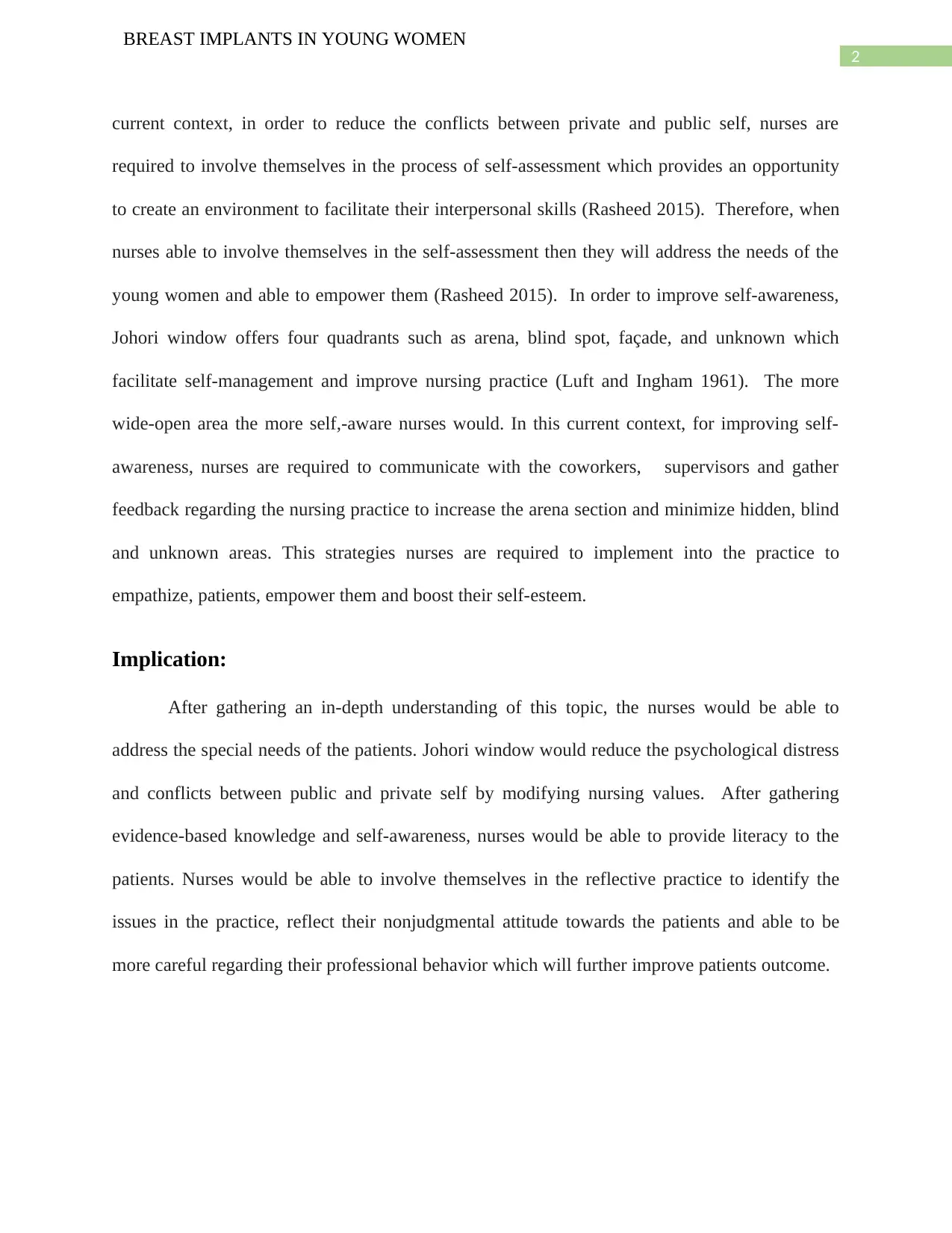
2
BREAST IMPLANTS IN YOUNG WOMEN
current context, in order to reduce the conflicts between private and public self, nurses are
required to involve themselves in the process of self-assessment which provides an opportunity
to create an environment to facilitate their interpersonal skills (Rasheed 2015). Therefore, when
nurses able to involve themselves in the self-assessment then they will address the needs of the
young women and able to empower them (Rasheed 2015). In order to improve self-awareness,
Johori window offers four quadrants such as arena, blind spot, façade, and unknown which
facilitate self-management and improve nursing practice (Luft and Ingham 1961). The more
wide-open area the more self,-aware nurses would. In this current context, for improving self-
awareness, nurses are required to communicate with the coworkers, supervisors and gather
feedback regarding the nursing practice to increase the arena section and minimize hidden, blind
and unknown areas. This strategies nurses are required to implement into the practice to
empathize, patients, empower them and boost their self-esteem.
Implication:
After gathering an in-depth understanding of this topic, the nurses would be able to
address the special needs of the patients. Johori window would reduce the psychological distress
and conflicts between public and private self by modifying nursing values. After gathering
evidence-based knowledge and self-awareness, nurses would be able to provide literacy to the
patients. Nurses would be able to involve themselves in the reflective practice to identify the
issues in the practice, reflect their nonjudgmental attitude towards the patients and able to be
more careful regarding their professional behavior which will further improve patients outcome.
BREAST IMPLANTS IN YOUNG WOMEN
current context, in order to reduce the conflicts between private and public self, nurses are
required to involve themselves in the process of self-assessment which provides an opportunity
to create an environment to facilitate their interpersonal skills (Rasheed 2015). Therefore, when
nurses able to involve themselves in the self-assessment then they will address the needs of the
young women and able to empower them (Rasheed 2015). In order to improve self-awareness,
Johori window offers four quadrants such as arena, blind spot, façade, and unknown which
facilitate self-management and improve nursing practice (Luft and Ingham 1961). The more
wide-open area the more self,-aware nurses would. In this current context, for improving self-
awareness, nurses are required to communicate with the coworkers, supervisors and gather
feedback regarding the nursing practice to increase the arena section and minimize hidden, blind
and unknown areas. This strategies nurses are required to implement into the practice to
empathize, patients, empower them and boost their self-esteem.
Implication:
After gathering an in-depth understanding of this topic, the nurses would be able to
address the special needs of the patients. Johori window would reduce the psychological distress
and conflicts between public and private self by modifying nursing values. After gathering
evidence-based knowledge and self-awareness, nurses would be able to provide literacy to the
patients. Nurses would be able to involve themselves in the reflective practice to identify the
issues in the practice, reflect their nonjudgmental attitude towards the patients and able to be
more careful regarding their professional behavior which will further improve patients outcome.
⊘ This is a preview!⊘
Do you want full access?
Subscribe today to unlock all pages.

Trusted by 1+ million students worldwide
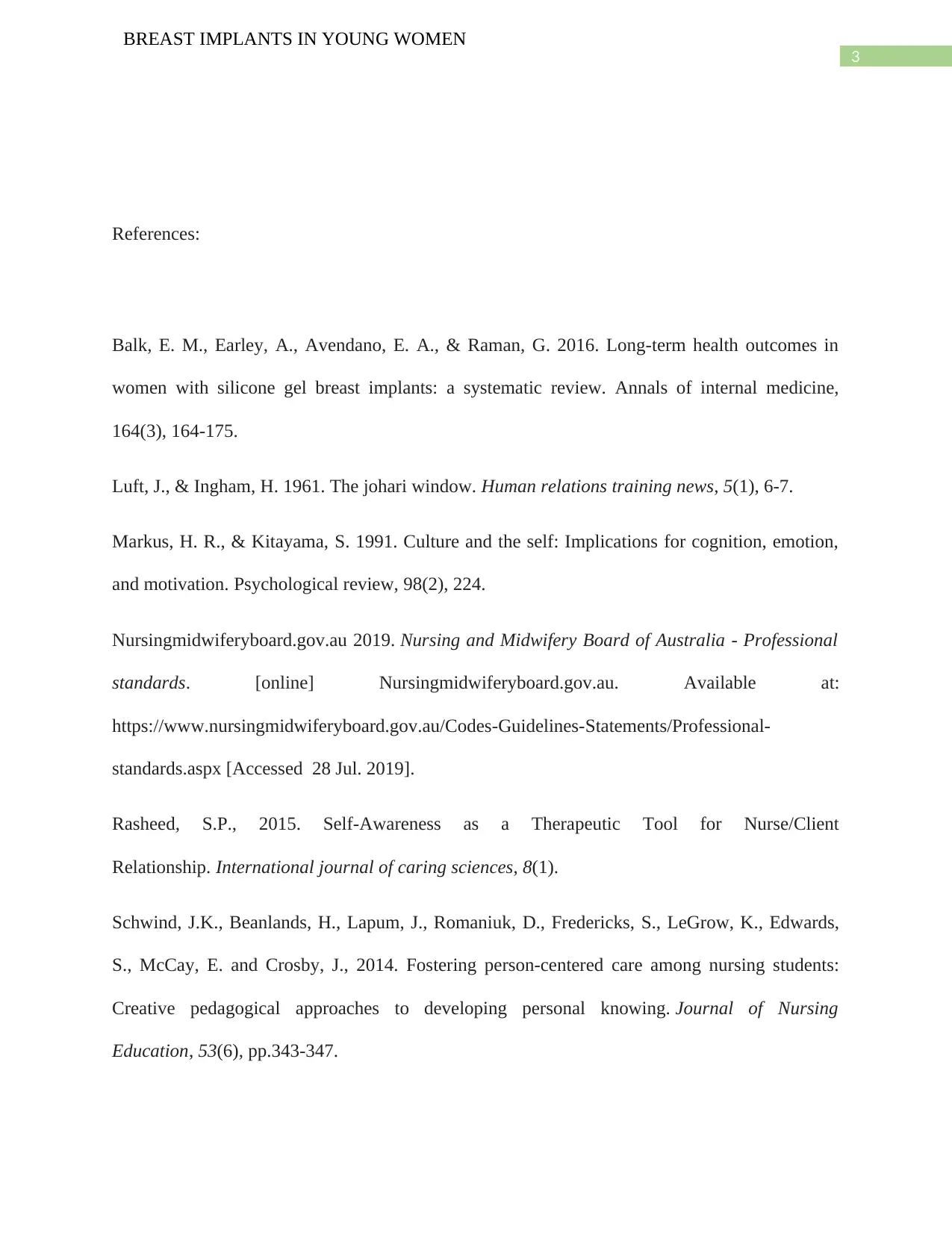
3
BREAST IMPLANTS IN YOUNG WOMEN
References:
Balk, E. M., Earley, A., Avendano, E. A., & Raman, G. 2016. Long-term health outcomes in
women with silicone gel breast implants: a systematic review. Annals of internal medicine,
164(3), 164-175.
Luft, J., & Ingham, H. 1961. The johari window. Human relations training news, 5(1), 6-7.
Markus, H. R., & Kitayama, S. 1991. Culture and the self: Implications for cognition, emotion,
and motivation. Psychological review, 98(2), 224.
Nursingmidwiferyboard.gov.au 2019. Nursing and Midwifery Board of Australia - Professional
standards. [online] Nursingmidwiferyboard.gov.au. Available at:
https://www.nursingmidwiferyboard.gov.au/Codes-Guidelines-Statements/Professional-
standards.aspx [Accessed 28 Jul. 2019].
Rasheed, S.P., 2015. Self-Awareness as a Therapeutic Tool for Nurse/Client
Relationship. International journal of caring sciences, 8(1).
Schwind, J.K., Beanlands, H., Lapum, J., Romaniuk, D., Fredericks, S., LeGrow, K., Edwards,
S., McCay, E. and Crosby, J., 2014. Fostering person-centered care among nursing students:
Creative pedagogical approaches to developing personal knowing. Journal of Nursing
Education, 53(6), pp.343-347.
BREAST IMPLANTS IN YOUNG WOMEN
References:
Balk, E. M., Earley, A., Avendano, E. A., & Raman, G. 2016. Long-term health outcomes in
women with silicone gel breast implants: a systematic review. Annals of internal medicine,
164(3), 164-175.
Luft, J., & Ingham, H. 1961. The johari window. Human relations training news, 5(1), 6-7.
Markus, H. R., & Kitayama, S. 1991. Culture and the self: Implications for cognition, emotion,
and motivation. Psychological review, 98(2), 224.
Nursingmidwiferyboard.gov.au 2019. Nursing and Midwifery Board of Australia - Professional
standards. [online] Nursingmidwiferyboard.gov.au. Available at:
https://www.nursingmidwiferyboard.gov.au/Codes-Guidelines-Statements/Professional-
standards.aspx [Accessed 28 Jul. 2019].
Rasheed, S.P., 2015. Self-Awareness as a Therapeutic Tool for Nurse/Client
Relationship. International journal of caring sciences, 8(1).
Schwind, J.K., Beanlands, H., Lapum, J., Romaniuk, D., Fredericks, S., LeGrow, K., Edwards,
S., McCay, E. and Crosby, J., 2014. Fostering person-centered care among nursing students:
Creative pedagogical approaches to developing personal knowing. Journal of Nursing
Education, 53(6), pp.343-347.
Paraphrase This Document
Need a fresh take? Get an instant paraphrase of this document with our AI Paraphraser
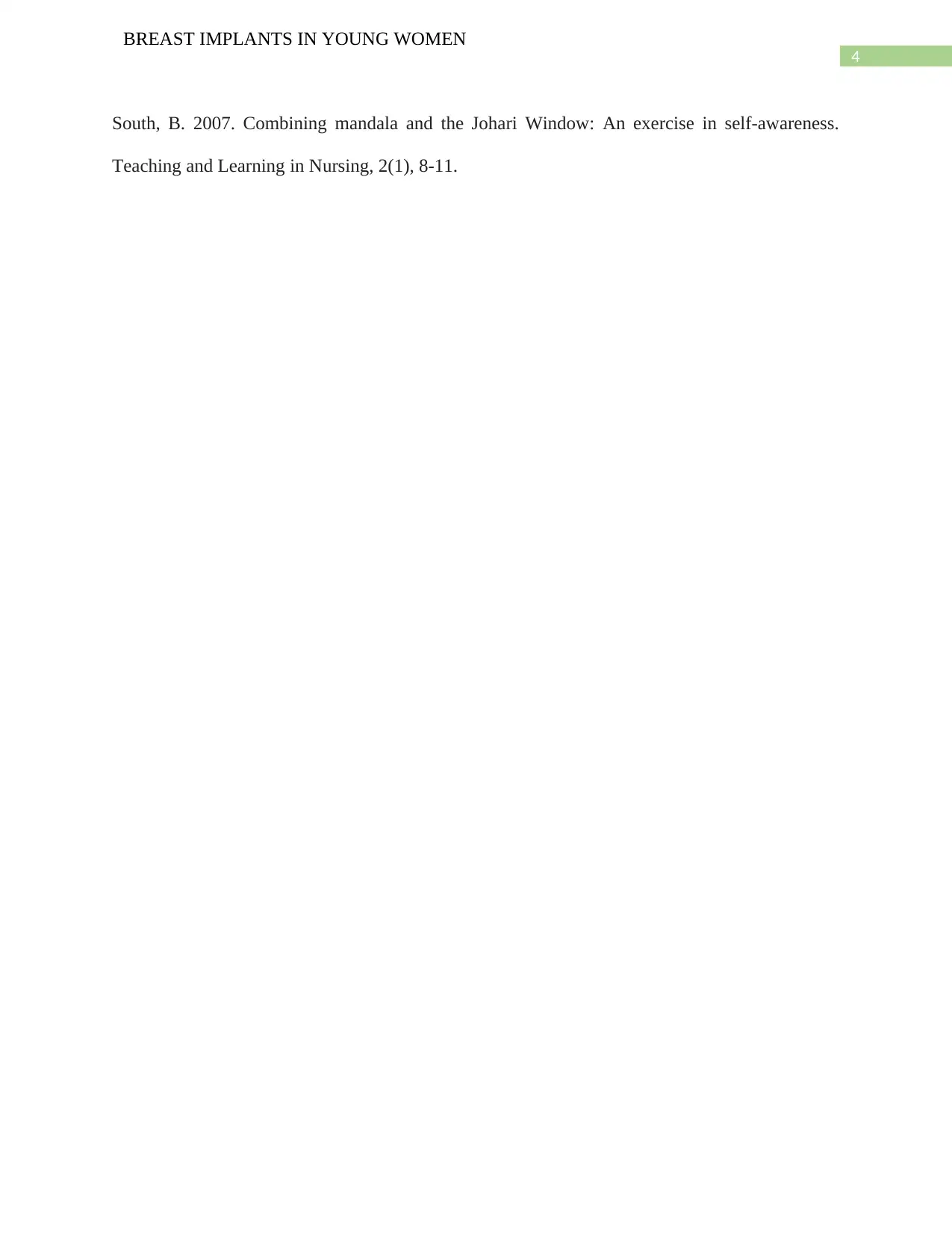
4
BREAST IMPLANTS IN YOUNG WOMEN
South, B. 2007. Combining mandala and the Johari Window: An exercise in self-awareness.
Teaching and Learning in Nursing, 2(1), 8-11.
BREAST IMPLANTS IN YOUNG WOMEN
South, B. 2007. Combining mandala and the Johari Window: An exercise in self-awareness.
Teaching and Learning in Nursing, 2(1), 8-11.
1 out of 5
Related Documents
Your All-in-One AI-Powered Toolkit for Academic Success.
+13062052269
info@desklib.com
Available 24*7 on WhatsApp / Email
![[object Object]](/_next/static/media/star-bottom.7253800d.svg)
Unlock your academic potential
Copyright © 2020–2025 A2Z Services. All Rights Reserved. Developed and managed by ZUCOL.



